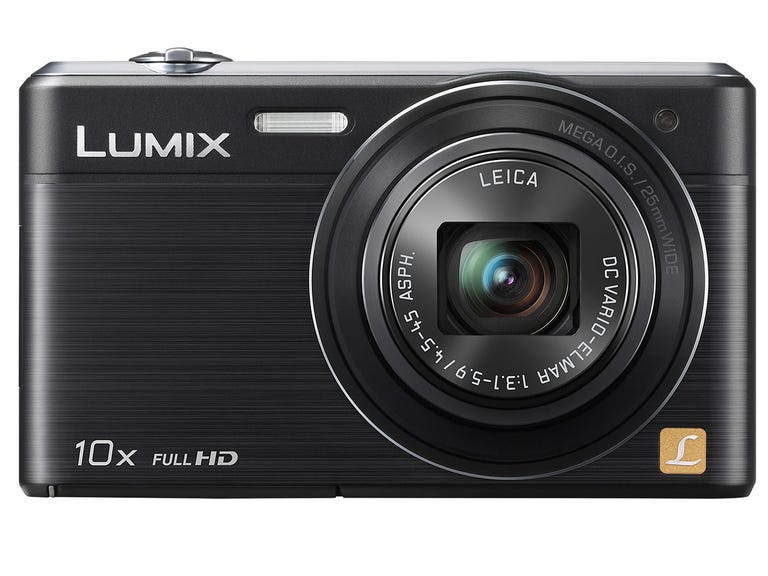 Why You Can Trust CNET
Why You Can Trust CNET Panasonic Lumix DMC-SZ9 review: Panasonic Lumix DMC-SZ9
The Lumix DMC-SZ9 is a high-quality compact camera with built-in Wi-Fi and free Android and iOS apps, but few manual controls.
The Lumix DMC-SZ9 is "every photographer’s friend", according to Panasonic, and you can see why. It’s small enough to take anywhere, easy to use, reliably takes a decent shot and is packed with handy features.
The Good
The Bad
The Bottom Line
Just shy of £200, it isn’t a bank breaker, either.
Wireless controls
By far the most impressive feature is its built-in Wi-Fi, which when connected to your local network lets you send images directly to your PC. Even more impressive is that if you have an Android or iOS device, you can control the camera remotely courtesy of the free Panasonic Image App.

I tested it using an iPhone, and the app offers one of the best wireless shooting experiences yet. You can zoom in and out using an onscreen slider, and tap the preview image to set the metering point. You can even set it so that a second tap fires the shutter. This is particularly impressive since the SZ9’s own screen isn’t touch-sensitive, so you can’t perform this function on the camera itself.
All of the camera’s primary functions are replicated within the app, including macro mode and self timer, and you can also use the phone’s built-in location tools to geocode your images, which means you’ll be able to position them on a map once they’ve been downloaded. Battery level and remaining images are fed back to the phone, all of which makes for a pretty perfect remote control and a far more elegant means of taking self-portraits than setting the shutter delay and running into the shot.
Core specs
Despite all this wireless trickery, the SZ9 is still extremely small -- shorter than a landscape iPhone 4/4S and easily slipped into a jeans front pocket -- yet Panasonic has somehow squeezed in a very impressive list of specs.
For starters, the lens offers a 10x zoom, which if it were part of a regular 35mm camera would take it from a satisfyingly wide 25mm to an impressive 250mm telephoto. Maximum aperture at the wider end is a respectable f/3.1, while at full zoom it’s a fairly regular f/5.9.
Minimum focusing distance in regular use stands at a flabby 50cm at wide angle and 1.5m when zoomed right in, but switching to macro mode cuts this to a more reasonable 5cm, although this still doesn’t put it to the top of the table, with rivals often boasting 3cm or better.
The macro results are good though, with a shallow depth of field producing a sharp subject and a rapid fall-off both before and aft to draw the eye.
The sensor runs to 16.1 megapixels and produces images up to 4,608x3,456 pixels, depending on your chosen aspect ratio. In a camera of this class there’s naturally no option for raw capture, but the JPEG compression has a light touch and doesn’t leave you with ugly artefacts.
In regular use, sensitivity tops out at ISO 3,200, although there’s a high sensitivity mode that will push it to ISO 6,400 if you need to shoot in very poor light or compensate for the regular four-second maximum shoot time in auto mode, and the one-second time you can select yourself in normal mode. If you need to leave it open for longer than this you’ll have to switch to starry sky mode, which locks it open for 30 seconds.
At its fastest, the SZ9 can expose the sensor for as little as 1/1,600 second, and achieve a burst speed of up to 5fps.
Be mindful that switching to high sensitivity reduces the maximum image size to 3 megapixels.
The SZ9 is a point-and-shoot through and through, so it pays to get familiar with the scene modes if you want to take more creative shots. There are 17 to choose from, taking in the usual range of image types including portrait, sports, scenery and food. They are supplemented by 14 less proscriptive creative modes, which are effectively filters for monochrome, high key, toy camera and so on.
The filters can be applied either at the point of shooting, or retrospectively, with the latter being by far the better choice since it lets you save the result as a separate image while preserving the untouched original. If you apply a filter while shooting you don’t get this option and you’ll only end up with the edited shot, which might not be to your taste.
Stills performance
I tested the SZ9 with quality set to fine and images recorded in their full 16.1-megapixel resolution.
Even when tasked with capturing detail in a narrow palette it put in an excellent performance. The plaque below is a fairly uniform green, yet zooming in reveals that the SZ9 has accurately rendered its uneven surface, with its bobbles and pits easily made out.
It was fast to find focus, even when I made significant changes to the framed subject, such as moving from a near-focus point to a more distant subject. At worst it took a second to settle itself on the new subject.
The automatic exposure system put in an impressive performance when faced with more difficult shots, too. In the image below, in which the beachscape is framed by a hole in a groyne, both elements are accurately exposed. The defocused wood retains its true colours, and although there is a very slight fringe on the inner ring of the knot hole it’s an impressive achievement overall.
So far, each of these images has been fairly conventional, but breaking the unwritten rules of photography and shooting towards the sun caused the SZ9 no great problems.
Naturally the subject became a silhouette, but even with hard reflections coming off the ripples in the sea in the image below it was able to maintain strong, largely crisp edges on this breakwater marker.
There was no evidence of any fringing in everyday landscape shots, and even when shooting complex subjects -- such as rigging crossing a brighter background -- it did an excellent job of focusing each wavelength of available light in sync with the others for a sharp, clean result.
Images were consistently balanced and were accurate reflections of each scene, with detail remaining sharp right into the corners of the image. This is an important consideration since the lens has to work harder in these parts to focus the incoming light on the sensor while bending it to a more extreme degree as it enters the camera body.
Still life test
Moving indoors for the still life test, the SZ9 produced a very impressive result under studio lighting. The image was sharp and grain free -- thanks to the low self-selected sensitivity of ISO 100 -- and colours were accurate. There was plenty of detail in subjects with natural texture, such as the wooden elephant and spice box, while the writing on the miniature spirit bottle and paint pots was clean, sharp and easy to read.
The result was less impressive when using the on-board flash though, with the SZ9 casting some pretty harsh shadows that affected the overall balance of the image and the contrast within some of the objects, such as the furry duster in the foreground and the contents of the spice box.
Video performance
The SZ9 has a range of shooting options to suit pretty much any requirement. At best, it can manage 50fps interlaced at 1,920x1,080, 50fps progressive at 1,280x720, and 25fps progressive at the full 1,920x1,080 pixels. Footage is stored in AVCHD format.
Actual recording options are few and far between, but you can choose whether auto-focus should remain active while shooting, or locked off when you start to record, and whether you want the SZ9 to filter out wind noise. I had both of these options turned on throughout my tests, and although there was still a fair amount of wind noise audible on my footage it wasn’t as strong as it was on the footage recorded by the Canon PowerShot S110, which I tested at the same time.
The 10x optical zoom remains accessible while recording, which is good, but you can hear its mechanics on the soundtrack, so it would be best practice to frame your subject as best you can before you start recording and then leave the zoom alone wherever possible.
Results were good, though, with the SZ9 compensating well for changes in the level of incoming light and recording accurate colours and -- when the wind wasn’t too strong -- a good clean soundtrack.
Conclusion
The SZ9 tips the scales at £199, which isn’t pocket money, but when you consider what you’re getting in return it still represents extremely good value. Image quality doesn’t seem to have been adversely affected by the high resolution of the sensor, the lens does a good job of keeping everything sharp, and the built-in Wi-Fi and free accompanying apps makes for a very tempting package all round.
In that respect, if £199 is your absolute limit and you’re not interested in retaining any manual control over the look of your pictures, it’s certainly one for the shortlist.
If you can stretch to £240 however, you can bag yourself the more capable Canon PowerShot S110. It has a do-it-all auto mode for those times when you just want to point and shoot, but will also give you greater creative control with shutter and aperture priority modes and raw shooting. It also has built in Wi-Fi, like the SZ9. Admittedly you’ll be paying a 20 per cent premium, but you are getting more than 20 per cent added value.
The question is whether you’d make use of that added value. Many would, but if you’ve never stepped out of auto, stick with the SZ9.


